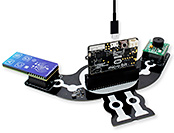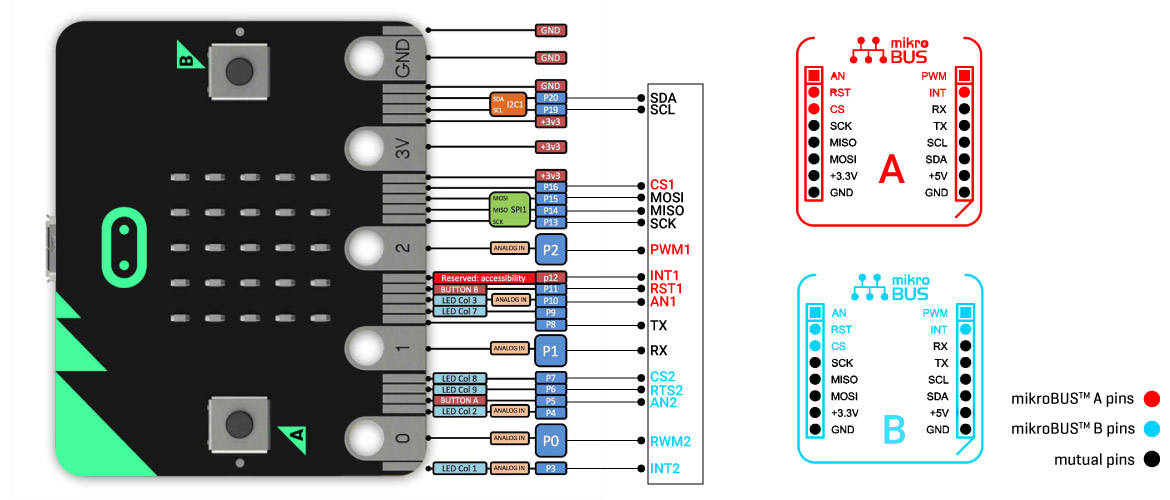|
|
| |
|
 | Search: |
|
|
|
|
|
 |

|
|
The BBC micro:bit is a credit card sized microcontroller development system, with a very simple and user-friendly visual programming interface, designed to introduce the kids to the world of embedded electronics. The micro:bit project is managed by the micro:bit Educational Foundation. This foundation is a non-profit organization with a very noble goal: giving children around the world a chance to get creative with the technology. You can find more information about the micro:bit project on the official web page.
However, this little development system can be interesting even for more experienced developers, because in its heart, there is a powerful nRF51822 MCU, a 16 MHz ARM Cortex-M0 microcontroller with 256 KB Flash and 16 KB RAM, beating. By inserting this ingeniously designed symmetrical development board into the micro:bit Click adapter, the world of possibilities grows exponentially: more than 400 different sensors, displays, drivers, radios, buttons, switches, faders, encoders, relays, converters, and more - neatly packed into the standardized Click boardâ„¢ form factor, will be just under your fingertips.
Once installed onto the micro:bit Click adapter, the BBC micro:bit can really open the doors to the world of embedded electronics for those who are more curious, who want to know more: take a peek at the device's official page, see which I2C slave address is required, which register turns on that BLUE channel of the RGB driver 3 click and send in the data. Put the I2C, SPI and Serial communication blocks of the micro:bit IDE to a good use!
Note: BBC's micro:bit is not included in the package. |
|
|
|
|
Overview
The BBC micro:bit is a credit card sized microcontroller development system, with a very simple and user-friendly visual programming interface, designed to introduce the kids to the world of embedded electronics. The micro:bit project is managed by the micro:bit Educational Foundation. This foundation is a non-profit organization with a very noble goal: giving children around the world a chance to get creative with the technology. You can find more information about the micro:bit project on the official web page.
However, this little development system can be interesting even for more experienced developers, because in its heart, there is a powerful nRF51822 MCU, a 16 MHz ARM Cortex-M0 microcontroller with 256 KB Flash and 16 KB RAM, beating. By inserting this ingeniously designed symmetrical development board into the micro:bit Click adapter, the world of possibilities grows exponentially: more than 400 different sensors, displays, drivers, radios, buttons, switches, faders, encoders, relays, converters, and more - neatly packed into the standardized Click boardâ„¢ form factor, will be just under your fingertips.
Once installed onto the micro:bit Click adapter, the BBC micro:bit can really open the doors to the world of embedded electronics for those who are more curious, who want to know more: take a peek at the device's official page, see which I2C slave address is required, which register turns on that BLUE channel of the RGB driver 3 click and send in the data. Put the I2C, SPI and Serial communication blocks of the micro:bit IDE to a good use!
Note: BBC's micro:bit is not included in the package.

Main features

The micro:bit Click adapter comes comes equipped with two proprietary mikroBUSâ„¢ sockets, allowing all the Click boardâ„¢ devices to be interfaced with the micro:bit with no efforts at all. It is enough to place the small standardized add-on board of your choice on the top of the mikroBUSâ„¢ socket - and click it in. That is why this small add-on board is called Click boardâ„¢ - it just clicks!
The mikroBUSâ„¢ standard is founded and maintained by MikroElektronika company, allowing all the various Click boardsâ„¢ to perfectly fit in, without any compatibility issues. Besides the 3.3V available from the micro:bit itself, the micro:bit Click adapter offers an additional 5V power supply (switchable through the onboard switch), required by some of the Click boardsâ„¢. This allows interfacing with an extended range of different devices. More information about the mikroBUSâ„¢ standard can be found on the official mikroBUSâ„¢ page.
Power your inventions
 The micro:bit Click adapter is powered from the micro:bit itself. An 80pin edge connector allows easy installation to the micro:bit board. Due to the micro:bit symmetrical design, there is no wrong way of connecting. It can be plugged into the connector both ways, keeping it simple.
mikroBUSâ„¢ pinout

Specification Table
| Type |
Adapter |
| Applications |
Adding Click board functionalities to the micro:bit |
| On-board modules |
Two mikroBUSâ„¢ sockets, 80pin edge connector for the micro:bit board |
| Interface |
PWM,UART,Analog,I2C,SPI |
| Input Voltage |
3.3V,5V |
|
|

